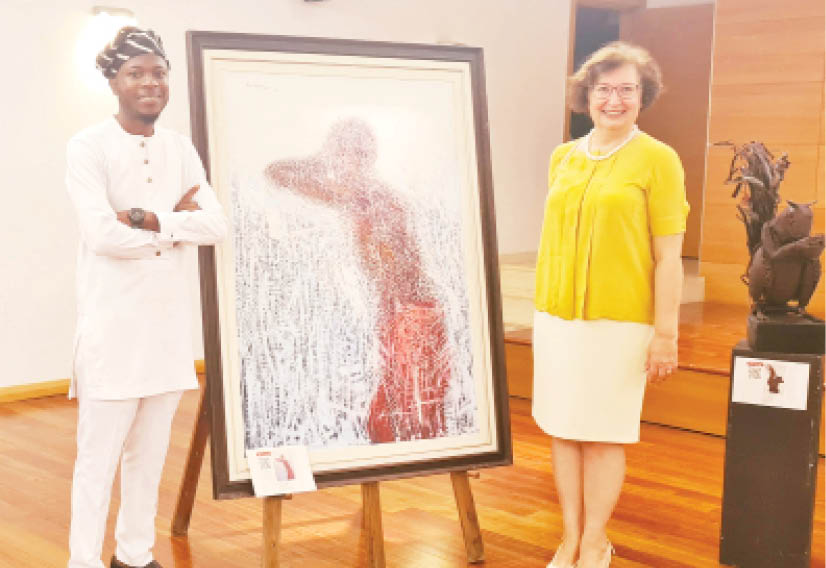Art can teach us a lot about what matters – Nike Opadiran
For corporate lawyer Nike Opadiran, collecting art by emerging Black artists is a way to create a more affirming space in her home and to support artists who are creating visual narratives that centre on Black people and their stories. Born and raised in Toronto, Nike Opadiran moved to the U.S. to study at Harvard […]

Sor Sen with one of the Turkish officials that attended an exhibition of works by some selected artists titled ‘The Passage’
For corporate lawyer Nike Opadiran, collecting art by emerging Black artists is a way to create a more affirming space in her home and to support artists who are creating visual narratives that centre on Black people and their stories. Born and raised in Toronto, Nike Opadiran moved to the U.S. to study at Harvard Law School and has lived in Washington D.C., for over a decade. She started her collecting journey in 2017.
Can you describe your collection in a sentence or less?
A body of works, mainly by emerging artists, that explore questions of how, and in what ways, the stories of Black peoples can be understood in today’s society.
Why did you start collecting art?
I was inspired by Peggy Cooper Cafritz. She built an unparalleled collection of works by artists across the African diaspora. Seeing it showed me the power of visual narratives and that art, done well, can teach us a lot about this world and what matters. It made me want to support young Black creatives who were interested in exploring ideas that could help us understand our history, culture, and humanity in truer ways.

What is a piece you own that people are often drawn to or ask you about frequently?
Hard Light (2018) by Kudzanai-Violet Hwami depicts a father and son embracing. It is based on the relationship between Hwami’s brother and father (who live in the U.K. and South Africa, respectively). The piece is a reflection on absence, reunion, and hope and the effects of geopolitical dislocations.
Can you tell us about an artist you’ve discovered?
A young photographer, Kennedi Carter, was profiled in Artsy Editorial in July 2020. That fall, I acquired one of her self-portraits through Artsy. Later that year, Carter made history as the youngest person to shoot a British Vogue cover when she photographed Beyoncé for the December 2020 issue.
Can you tell us about a piece you recently bought?
In September, I acquired a painting by Ojo Ayotunde from Nyama Fine Art. I saw a photo of a piece from Ayotunde’s “The Isolation Series” in a news article about Future Fair. Thereafter, through Artsy, I inquired with the gallery about available works and was fortunate enough to acquire a piece from that series.
What is your collecting process like?
I collect almost exclusively online. I am a mergers and acquisitions and finance attorney in the renewable energy space and I work at a big law firm. Unfortunately, that means my work schedule is not flexible enough to allow me the time needed to attend a lot of fairs or gallery openings.
What is the biggest challenge you encounter as an art collector? How have you overcome it?
Galleries and artists give preference to more established and better-known collectors with deeper pockets and more influence than me. So, I focus on artists who are at the early stages of their career, or who make bodies of work that garner less commercial attention. Initially, that meant that I acquired works directly from artists who were in school and through galleries offering those artists their first shows. Now, it means I support a lot of artists who do not have MFAs or whose practices do not centre on figurative paintings.

How do you build relationships with galleries?
I rely on in-person connections. Fairs work well for this, as does visiting a gallery outside of an opening reception.
What trends are you seeing in the art market?
I am very much a fan of Black figuration and its increased prominence in today’s art world. Yet, I know that the art market is part of, and mirrors, modern capitalism. And I know the ways in which American capitalism was built off, and is still sustained by, the consumption of Black bodies. That discomforts me. So, I appreciate works that investigate Black identity and our experiences without literal representation.
When you’re deciding whether or not to buy an artist’s work, what’s the most important information that helps you make that decision?
I need to connect intuitively with the pieces I collect. Additionally, I consider how much I like the artist’s work generally, how the piece fits within that artist’s body of work, whether it feels derivative, and how well the artist is positioned for long-term success. These additional factors carry less weight for works I acquire at a more modest price point.
What do you enjoy most about being a collector?
The art in my home gives me respite from spaces where I am often “othered” as a Black woman. There is peace in that.
I have relationships with artists and fellow collectors that exist beyond the confines of this art world. There is real joy in that.
This interview was culled from Artsy.com
